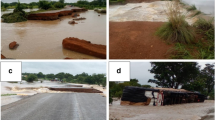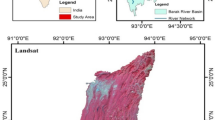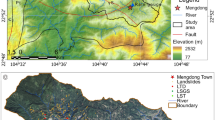The RUSLE-3D (Revised Universal Soil Loss Equation-3D) model was implemented in geographic information system (GIS) for predicting the soil loss and the spatial patterns of soil erosion risk required for soil conservation planning. High resolution remote sensing data (IKONOS and IRS LISS-IV) were used to prepare land use/land cover and soil maps to derive the vegetation cover and the soil erodibility factor whereas Digital Elevation Model (DEM) was used to generate spatial topographic factor. Soil erodibility (K) factor in the sub-watershed ranged from 0.30 to 0.48. The sub-watershed is dominated by natural forest in the hilly landform and agricultural land in the piedmont and alluvial plains. Average soil loss was predicted to be lowest in very dense forest and highest in the open forest in the hilly landform. Agricultural land-1 and agriculture land-2 to have moderately high and low soil erosion risk, respectively. The study predicted that 15% area has ‘moderate’ to ‘moderately high’ and 26% area has high to very high risk of soil erosion in the sub-watershed.







Similar content being viewed by others
References
Arya S L and Samra J S 2001 Revisiting watershed management institutions in Haryana Shivaliks, India; Annual Report CSWCRTI, Research Centre, Chandigarh, pp. 104–105.
CGWB 2009 Ground Water Brochure of Haridwar District; Central Ground Water Board (CGWB), Uttaranchal Region, Ministry of Water Resources, Government of India, Delhi.
Desmet P J J and Govers G 1996 A GIS procedure for automatically calculating the USLE LS factor on topographically complex landscape units; J. Soil Water Conservat. 51 427–433.
Dhruva Narayana V V 1987 Downstream impacts of soil conservation in the Himalayan region; Mountain Res. Develop. 7(3) 287–298.
Efe R, Ekinci D and Curebel I 2008 Erosion analysis of Findikl creek catchment (NW of Turkey) using GIS based on RUSLE (3d) method; J. Appl. Sci. 8(1) 49–58.
Evan R 1980 Mechanics of water erosion and their spatial and temporal controls: An empirical viewpoint; In: Soil erosion (eds) Kirkby M J and Morgan R P C (Chichester: Wiley), pp. 109–128.
FSI 2009 State of Forest Report 2007, Forest Survey of India; Ministry of Environment and Forest, Dehradun.
Hoyos N 2005 Spatial modeling of soil erosion potential in a tropical watershed of the Colombian Andes; Catena 63 85–108.
IIRS 2007 Bio-geo database creation and sustainable development planning in Pathri Rao sub-watershed; Project Report submitted by Indian Institute of Remote Sensing (IIRS), NRDMS Division, Department of Science and Technology, Govt. of India, New Delhi.
Jackson M L 1967 Soil chemical analysis; Prentice Hall India Pvt. Ltd., New Delhi.
King C, Baghdadi N, Lecomte V and Cerdan 2005 The application of remote sensing data to monitoring and modeling of soil erosion; Catena 62 79–93.
Kushwaha S P S, Mukhopadhyay S, Hari Prasad V and Suresh Kumar 2010 Sustainable development planning in Pathri Rao sub-watershed using geospatial techniques; Curr. Sci. 98(1) 1479–1486.
Lal R 1998 Soil erosion impact on agronomic productivity and environment quality: Critical review; Plant Sci. 17 319–464.
Lu D, Li G, Valladares G S and Batistella M 2004 Mapping soil erosion risk in Rondonia, Brazilian Amazonia: Using RUSLE, remote sensing and GIS; Land Degradation & Develop. 15 499–512.
Millward A A and Mersey J E 1999 Adapting the RUSLE to model soil erosion potential in a mountainous tropical watershed; Catena 38(2) 109–229.
Mitasova H, Hofierka J, Zlocha M and Iverson L R 1996 Modelling topographic potential for erosion and deposition using GIS; Int. J. Geogr. Inform. Syst. 10 629–641.
Moore I D and Burch G J 1986 Physical basis of the length-slope factor in the universal soil loss equation; Soil Sci. Soc. Am. J. 50(5) 1294–1298.
Moore D and Wilson J P 1992 Length-slope factors for the revised universal soil loss equation: Simplified method of estimation; J. Soil Water Conservat. 47 423–428.
Narain P, Khybri M L, Tomar H P S and Sindhwal N S 1994 Estimation of run-off, soil loss and USLE parameters for Doon valley; Indian J. Soil. Cons. 22(3) 129–132.
Park S, Oh C, Jeon S, Jung H and Choi C 2011 Soil erosion risk in Korean watersheds, assessed using the revised universal soil loss equation; J. Hydrol. 399(3–4) 263–273.
Popp J H, Hyatt D E and Hoag D 2000 Modeling environmental condition with indices: A case study of sustainability and soil resources; Ecol. Model. 130(1–3) 131–143.
Renard K G, Foster G R, Weesies G A, McCool D K and Yoder D C 1997 Predicting soil erosion by water: A guide to conservation planning with the revised universal soil loss equation (RUSLE); USDA Handbook, 703, U.S. Department of Agriculture, Washington, DC.
Renard K D, Foster G R, Weesies G A and Porter J P 1991 RUSLE Revised universal soil loss equation; J. Soil Water Conservat. 46(1) 30–33.
Risse L M, Nearing M A, Nicks A D and Laflen J M 1993 Error assessment in the universal soil loss equation; Soil Sci. Soc. Am. J. 57(3) 825–833.
Roose E J 1977 Application of the universal soil loss equation of Wischmeier and Smith in West Africa; In: Soil conservation and management in the humid tropics (eds) Greenland D J and Lal R London; Wiley, pp. 177–187.
Sehgal J L, Saxena R K and Vadivelu S 1987 Field Manual Soil Resource Mapping of different states in India; Tech. Bull. NBSS Publ. 13, NBSS&LUP, Nagpur.
Sidhu G S, Walia C S, Sachdev C B, Rana K P C, Dhankar R P, Singh S P and Velayutham M 2000 Soil resource of NW Shivaliks for prospective land use planning; In: Fifty Years of Research on Sustainable Resource Management in Shivaliks (eds) Mittal S P, Aggrawal R K and Samara J S, Central Soil & Water Conservation Research and Training Institute, Research Centre Chandigarh, India, pp. 3–34.
Sidle R C, Taylor D, Lu X X, Adger W N, Lowe D J, deLange W P, Newnham R N and Dodson J R 2004 Interactions of natural hazards and society in Austral-Asia: Evidence in past and recent records; Quart. Int. 118/119 181–203.
Singh G, Ram Babu and Chandra S 1981 Soil loss prediction research in India; Tech. Bull. T-12/D-9, Central Soil and Water Conservation Research and Training Institute, Dehradun, India.
Singh G, Ram Babu, Narain P, Bhusan L S and Abrol I P 1992 Soil erosion rates in India; J. Soil Water Conservat. 47(1) 97–99.
Shi Z H, Cai C F, Ding S W, Wang T W and Chow T L 2004 Soil conservation planning at the small watershed level using RUSLE with GIS: A case study in the Three Gorge Area of China; Catena 55 33–48.
Soil Survey Division Staff 2003 Soil Survey Manual; Handbook 18, USDA, Washington DC.
Terranova O, Antronico L, Coscarelli R and Iaquinta P 2009 Soil erosion risk scenarios in the Mediterranean environment using RUSLE and GIS: An application model for Calabria (southern Italy); Geomorphology 11(3–4) 228–245.
Tiwari A K 2004 Effective bio-engineering measures for torrent and erosion control in Shivaliks; In: Compendium National Symposium on enhancing productivity and sustainability in hill and mountain agro-ecosystem (ed.) Sharda V N, CSWCRTI, Dehradun.
Valdiya K S and Bartarya S K 1989 Problem of mass movements in a part of Kumaun Himalaya; Curr. Sci. 58 486–491.
Wischmeier W H and Smith D D 1978 Predicting rainfall erosion losses: A guide to conservation planning; USDA Handbook, 537p.
Woo M and Luk S 1990 Vegetation effects on soil and water losses on weathered granitic hillslopes, south China; Phys. Geogr. 11 1–16.
Yadav R P, Aggarwal R K, Bhattacharyya P and Bansal R C 2005 Infiltration characteristics of different aspects and topographical locations of hilly watershed in Shivalik-lower Himalayan region in India; Indian J. Soil Conservat. 33(1) 44–48.
Zhou P, Luukkanen O, Tokola T and Nieminen J 2008 Effect of vegetation cover on soil erosion in a mountainous watershed; Catena 75 319–325.
Acknowledgements
The authors wish to thank Director, Indian Institute of Remote Sensing for the encouragement and support during the course of the study. They also acknowledge the financial support from NRDMS, DST, Govt. of India, New Delhi for the project. Thanks are also due to the Chief Wildlife Warden, Uttarakhand for permitting them to work in sub-watershed falling in the Rajaji National Park.
Author information
Authors and Affiliations
Corresponding author
Rights and permissions
About this article
Cite this article
KUMAR, S., KUSHWAHA, S.P.S. Modelling soil erosion risk based on RUSLE-3D using GIS in a Shivalik sub-watershed. J Earth Syst Sci 122, 389–398 (2013). https://doi.org/10.1007/s12040-013-0276-0
Received:
Revised:
Accepted:
Published:
Issue Date:
DOI: https://doi.org/10.1007/s12040-013-0276-0




